National Alcohol Indicators Project (NAIP)
The National Alcohol Indicators Project (NAIP), which is supported by funding from the Australian Government Department of Health, is a nationally coordinated project aimed at tracking and reporting on trends in alcohol-related harm in Australia at national, state and local levels. One of the main objectives of the project is to develop a set of indicators for the continual monitoring and evaluation of the effectiveness of state and national alcohol policies. An interactive data visualisation tool, seventeen statistical bulletins and one report have been published so far (to view the outputs, click on the corresponding thumbnail):
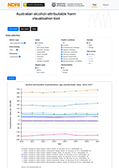 Australian alcohol-attributable harm visualisation tool.
Australian alcohol-attributable harm visualisation tool.
This visualisation tool can be used to identify state-by-state and national trends in alcohol-attributable hospitalisations and deaths in Australia. Alcohol-attributable fractions were produced using the open access alcohol harms estimator, InterMAHP, and applied to unit records of hospitalisation and death data. Age-, gender- and region-specific counts and rates of alcohol-attributable harm can be selected and viewed as line charts, bar charts or maps.
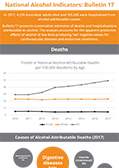 Bulletin 17: Estimated alcohol-attributable deaths and hospitalisations in Australia, 2010 to 2017.
Bulletin 17: Estimated alcohol-attributable deaths and hospitalisations in Australia, 2010 to 2017.
National Alcohol Indicators bulletin 17 shows that in 2017 an estimated 4,276 Australian adults died and 105,505 were hospitalised from alcohol-attributable causes. The bulletin presents ‘net’ deaths and hospitalisations by applying the alcohol attributable fraction method. This analysis takes into account the apparent protective effects of alcohol at low dose for ischaemic heart disease, haemorrhagic and ischaemic stroke, acute pancreatitis and diabetes type 2. To explore trends presented in the bulletin further and to see more detailed methods and acknowledgments, please visit our alcohol-attributable harm visualisation tool above.
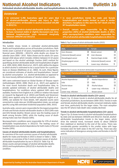 Bulletin 16: Estimated alcohol-attributable deaths and hospitalisations in Australia, 2004 to 2015.
Bulletin 16: Estimated alcohol-attributable deaths and hospitalisations in Australia, 2004 to 2015.
National Alcohol Indicators bulletin 16 documents numbers and trends for alcohol-attributable deaths and hospitalisations across all Australian jurisdictions using the latest Burden of Disease Methods. The bulletin shows that an estimated 5,785 Australians aged 15+ years died of alcohol-attributable disease and injury in 2015, while hospitalisations attributable to alcohol exceeded 144,000 in 2012/13. Trends in alcohol-attributable deaths appeared to have remained stable or slightly decreased over time. National hospitalisation rates increased marginally between 2003/04 and 2012/13.
Supplementary Tables 1 and 2 - Estimated death counts and rates (pdf)
Supplementary Tables 3 and 4 - Estimated hospitalisation counts and rates (pdf)
Acknowledgements (pdf)
References (pdf)
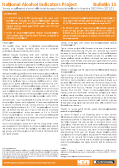 Bulletin 15: Trends in estimated alcohol-attributable assault hospitalisations in Australia 2003/04 to 2012/13.
Bulletin 15: Trends in estimated alcohol-attributable assault hospitalisations in Australia 2003/04 to 2012/13.
NAIP Bulletin 15 shows trends in estimated alcohol-attributable assaults in Australia from 2003/04 to 2012/13. Rates of estimated alcohol-attributable assaults were calculated by applying the alcohol aetiologic fraction (AAF) method to hospital morbidity data. Nationally, the trend showed a slight decline in alcohol-attributable assaults over the period. Rates of male alcohol-attributable assaults were higher than female rates across all jurisdictions except the NT. The rates for males aged 15-29 were highest across all jurisdictions.
Supplementary Table 1 - Estimated rates (pdf)
Supplementary Table 2 - Estimated counts (pdf)
Acknowledgements (pdf)
References (pdf)
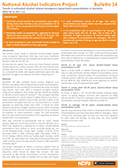 Bulletin 14: Trends in estimated alcohol-related emergency department presentations in Australia, 2005-06 to 2011-12.
Bulletin 14: Trends in estimated alcohol-related emergency department presentations in Australia, 2005-06 to 2011-12.
NAIP Bulletin 14 is the first Australian publication to document nationwide trends over time in alcohol-related ED presentations. The bulletin shows estimated trends in alcohol-related ED presentations based on presentations with an 'injury' related primary diagnosis on weekend nights. Presentation rates were higher among males than females across all jurisdictions, however the rate that Australian women presented at emergency departments (ED) on weekends for alcohol-related injuries increased faster than for males. Rates of teenage presentations were higher than any of the other age groups, likely indicating higher prevalence of alcohol-related night time weekend ED presentations for teenagers.
Estimated rates of alcohol-related injury presentations to EDs (pdf)
Acknowledgements (pdf)
References (pdf)
ICD Codes (pdf)
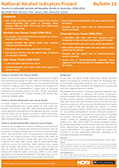 Bulletin 13: Trends in estimated alcohol-attributable deaths in Australia, 1996-2010: Alcoholic liver disease, liver cancer, and colorectal cancer.
Bulletin 13: Trends in estimated alcohol-attributable deaths in Australia, 1996-2010: Alcoholic liver disease, liver cancer, and colorectal cancer.
NAIP Bulletin 13 documents trends in estimated alcohol-attributable deaths in Australia, between 1996 and 2010. The bulletin shows trends in estimated population adjusted rates of deaths attributable to risky/high risk alcohol consumption for three chronic conditions: alcoholic liver disease, liver cancer and colorectal cancer. This bulletin shows that between 1996 and 2010 over 16,000 Australians died from alcoholic liver disease, alcohol-attributable liver cancer or colorectal cancer. Annual figures and rates for each of the conditions are presented for all states and territories.
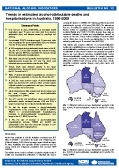 Bulletin 12: Trends in estimated alcohol-attributable deaths and hospitalisations in Australia, 1996-2005.
Bulletin 12: Trends in estimated alcohol-attributable deaths and hospitalisations in Australia, 1996-2005.
NAIP Bulletin 12 documents trends in alcohol-attributable deaths and hospitalisations across all Australian jurisdictions. This bulletin shows that between 1996-2005, an estimated 32,696 Australians aged 15 years and older died from alcohol-attributable injury and disease caused by risky/high risk drinking. An estimated 813,072 Australians aged 15 years and older were also hospitalised. This bulletin, which shows rates of alcohol-caused deaths are relatively stable while hospitalisation rates are increasing, also includes estimates of non-alcohol-attributable deaths and hospitalisations.
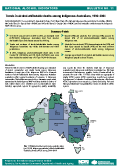 Bulletin 11: Trends in alcohol-attributable deaths among Indigenous Australians, 1998-2004.
Bulletin 11: Trends in alcohol-attributable deaths among Indigenous Australians, 1998-2004.
The eleventh NAIP Bulletin is the first of a series of bulletins focusing on indicators of alcohol consumption and related harms among Indigenous Australians. This bulletin documents trends in alcohol-attributable harms among Indigenous Australians between 1998-2004. An estimated 1145 Indigenous Australians died from alcohol-attributable injury and disease in that period, mostly due to suicide and alcoholic liver cirrhosis. Annual figures and rates are presented for all states and territories.
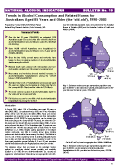 Bulletin 10: Trends in Alcohol Consumption and Related Harms for Australians Aged 85 Years and Older (the 'old-old'), 1990-2003.
Bulletin 10: Trends in Alcohol Consumption and Related Harms for Australians Aged 85 Years and Older (the 'old-old'), 1990-2003.
The tenth bulletin documents trends in alcohol-attributable harms due to risky and high risk drinking among those aged 85 years and over in Australia. An estimated 1,526 'old-old' Australians died from alcohol-attributable injury and disease between 1994 and 2003, mostly due to strokes and falls. Falls were also the most common cause of hospitalisations in this age group. Annual rates for all states and territories have been presented, as well as a comparison between metropolitan and non-metropolitan regions.
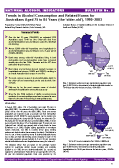 Bulletin 9: Trends in Alcohol Consumption and Related Harms for Australians Aged 75 to 84 Years (the 'older-old'), 1990-2003.
Bulletin 9: Trends in Alcohol Consumption and Related Harms for Australians Aged 75 to 84 Years (the 'older-old'), 1990-2003.
The ninth bulletin documents trends in alcohol-attributable harms due to risky and high risk drinking among Australians aged 75-84 years. An estimated 3,320 'older-old' Australians died from alcohol-attributable injury and disease between 1994 and 2003, mostly due to haemorrhagic stroke and alcoholic liver cirrhosis. Falls were the most common cause of hospitalisations in this age group. Annual rates for all states and territories have been presented, as well as a comparison between metropolitan and non-metropolitan regions.
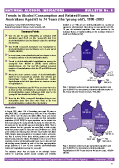 Bulletin 8: Trends in Alcohol Consumption and Related Harms for Australians Aged 65 to 74 Years (the 'young-old'), 1990-2003.
Bulletin 8: Trends in Alcohol Consumption and Related Harms for Australians Aged 65 to 74 Years (the 'young-old'), 1990-2003.
The eighth bulletin documents trends in alcohol-attributable harms due to risky and high risk drinking among those aged 65-74 years in Australia. An estimated 5,746 'young-old' Australians died from alcohol-attributable injury and disease between 1994 and 2003, mostly due to alcoholic liver cirrhosis and haemorrhagic stroke. Falls were the most common cause of hospitalisations in this age group. Annual rates for all states and territories have been presented, as well as comparisons between Indigenous and non-Indigenous people and metropolitan and non-metropolitan regions.
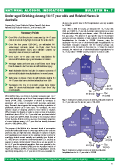 Bulletin 7: Under-aged Drinking Among 14-17 year olds and Related Harms in Australia.
Bulletin 7: Under-aged Drinking Among 14-17 year olds and Related Harms in Australia.
The seventh bulletin documents trends in alcohol-attributable harms due to under-aged drinking among 14-17 year olds in Australia. Between 1993-2002, an estimated 501 under-aged drinkers (aged 14-17) died from alcohol-attributable injury and disease, due mainly to road injury, suicide and violence. Over 80% of alcohol consumed by 14-17 year olds is drunk at high risk levels for acute harm. This bulletin presents state trends in alcohol-attributable deaths and hospitalisations and compares the proportion of alcohol drunk at high risk levels by 14-17 years old with the general population.
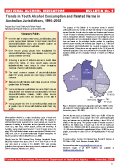 Bulletin 6: Trends in youth alcohol consumption and related harms in Australian jurisdictions, 1990-2002.
Bulletin 6: Trends in youth alcohol consumption and related harms in Australian jurisdictions, 1990-2002.
The sixth Bulletin documents trends in alcohol-attributable harms due to risky and high risk drinking for young people aged 15-24 yrs across Australia. Annual rates for males and females aged between 15 and 24 years for all states and territories have been presented, as well as comparisons between Indigenous and non-Indigenous youth and metropolitan and non-metropolitan regions. Over 2,643 young people have died in the last ten years from alcohol-attributable injury and disease; mostly due to road injury, suicide and violence.
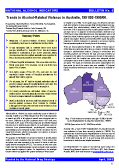 Bulletin 5: Trends in Alcohol-related violence in Australia, 1991/92-1999/00.
Bulletin 5: Trends in Alcohol-related violence in Australia, 1991/92-1999/00.
The fifth Bulletin documents trends in alcohol-related violence throughout Australian states and territories between 1991/92 and 1999/00 using both police and hospital data. Measures of alcohol-related violence indicated consistently high levels in Australia in the 1990s with an estimated 8,661 people admitted to hospital for injuries caused by violent assault in 1998/99. Seventy four percent of people admitted to hospital with assaultive injuries were male and two-thirds were aged between 15 and 34 years. Non-metro regions had markedly higher levels of violence than metro areas.
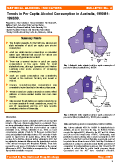 Bulletin 4: Trends in Per Capita Alcohol Consumption in Australia, 1990/91-1998/99.
Bulletin 4: Trends in Per Capita Alcohol Consumption in Australia, 1990/91-1998/99.
Trends in Australian per capita alcohol consumption were reported for the first time at national and state/territory levels for the 1990s. Methodological refinements were made with regard to estimating numbers of consumers of alcohol as well as typical beverage strengths. The end result is a more accurate indication of true levels of alcohol consumption than previous estimates. There was a general decline in per capita consumption in the early 1990s for most regions. More recently consumption has been rising in those few jurisdictions continuing to collect the necessary data. Consumption was consistently highest in the NT and lowest in Vic. Non-metropolitan consumption was consistently higher than for metropolitan regions. The reports also highlight current problems in accessing the data required to measure per capita consumption.
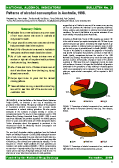 Bulletin 3: Patterns of Alcohol consumption in Australia, 1998.
Bulletin 3: Patterns of Alcohol consumption in Australia, 1998.
The 1998 National Drug Strategy Household Survey (AIHW) was used to estimate how much alcohol was consumed at risky levels for health in Australia. Thirty nine percent of all alcohol was consumed at levels which posed health risks in the long term. By comparison, 51% of all alcohol posed short-term health risks to drinkers. Proportions of Australian’s drinking in excess of NHMRC drinking levels are also presented by age and sex. Young people aged under 25 years had the riskiest drinking patterns.
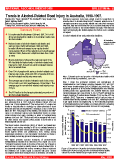 Bulletin 2: Trends in Alcohol-related road injury in Australia, 1990-1997.
Bulletin 2: Trends in Alcohol-related road injury in Australia, 1990-1997.
The second Bulletin documented trends in alcohol-related serious road injury throughout Australian states and territories between 1990 and 1997. It was estimated that 31% of all driver and pedestrian road deaths in Australia are alcohol-related. National rates of alcohol-related deaths and hospitalisations declined between 1990 and 1996, broadly following changes in per capita alcohol consumption. Most of the reduction occurred between 1990 and 1992. Most jurisdictions followed the National trend, only WA showed an increasing trend in serious road injuries.
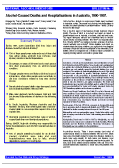 Bulletin 1: Alcohol-caused Deaths and Hospitalisations in Australia, 1990-1997.
Bulletin 1: Alcohol-caused Deaths and Hospitalisations in Australia, 1990-1997.
The first Bulletin documented national and jurisdictional rates of deaths caused by hazardous/harmful alcohol consumption between 1990 and 1997. It was estimated that 3,290 Australians died from injury and disease caused by hazardous/harmful alcohol consumption in 1997 and that over 72,000 hospital admissions were caused by high-risk drinking. About 70% of all alcohol-caused deaths and hospitalisations occurred among males and an average of 19 years of life were lost to premature death. From 1990 to 1997 death rates declined by over 20% with most of the decline between 1990 and 1993.
 Australian Alcohol Indicators, Patterns of Alcohol use and Related Harms for Australian States and Territories, 1990-2001.
Australian Alcohol Indicators, Patterns of Alcohol use and Related Harms for Australian States and Territories, 1990-2001.
Australian Alcohol Indicators, Patterns of Alcohol use and Related Harms for Australian States and Territories, 1990-2001 was released by the National Alcohol Indicators Project (NAIP) in November 2003. This major work presents health, road safety, industry and survey data to describe trends in risky alcohol use and serious alcohol-related harms for all Australian states and territories. It has been guided by principles set out in the World Health Organization’s International Guide for Monitoring Alcohol Consumption and Related Harm (WHO, 2000). Trends in alcohol-caused deaths and hospitalisations for all states and territories have not previously been reported using consistent and comparable methods. A comparison between levels of risky alcohol use reported in the 1998 and 2001 National Drug Strategy Household (NDSH) surveys is also presented for the first time. The report builds on and updates five earlier Statistical Bulletins from the National Alcohol Indicators Project (NAIP) concerning alcohol-caused deaths and hospitalisations, road crashes, alcohol-related violence and levels and patterns of drinking in Australia.
Australian Alcohol Indicators executive summary (pdf)
All Bulletins are free.
To order a printed copy email ndri@curtin.edu.au